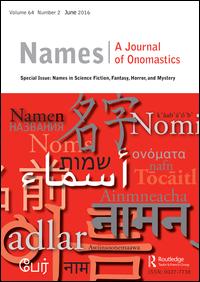Published 2011-09-01
Keywords
- CHINESE NAMES,
- HAO TING,
- MASCULINE/FEMININE NAMES
Copyright (c) 2011 Maney Publishing

This work is licensed under a Creative Commons Attribution 4.0 International License.
Abstract
AbstractWhere literary onomastics focuses on names in the context of a narrative, literary onomaturgy focuses on ensembles of names that share common features in their construction, over and beyond the texts in which the individual names appear. This approach gives serious consideration to wordplay and free association that other critical perspectives would treat as irrelevant, yet maintains methodological rigor thanks to its model of name creation. It furthermore treats semantic content as an element of construction, on a par with sound and form, that can be displaced from one name to another. While many of these elements get woven into the narratives in which the names appear, others get left out of the texts, but reappear in the fabrication of other names. In Le Guin's namecraft these internominal relationships cut across different texts and imaginary worlds, are open to great variety, and possess aesthetic properties that make the ensembles worthy of study and admiration on their own merits.
References
- Algeo, John. 1982. “Magic Names: Onomastics in the Fantasies of Le Guin.” Names 30: 59–67.
- Klein, Gérard. 2000. “Malaise dans la science-fiction américaine.” Ursula Le Guin, Le Dit d’Aka. Paris: Robert Laffont, 311–382.
- Le Guin, Ursula K. 1966a. Rocannon’s World. New York: Harper & Row.
- Le Guin, Ursula K. 1966b. Planet of Exile. New York: Harper & Row.
- Le Guin, Ursula K. 1967. City of Illusions. New York: Harper & Row.
- Le Guin, Ursula K. 1968. A Wizard of Earthsea. New York: Atheneum.
- Le Guin, Ursula K. 1969. The Left Hand of Darkness. New York: Ace Books.
- Le Guin, Ursula K. 1971. The Tombs of Atuan. New York: Atheneum.
- Le Guin, Ursula K. 1972. The Farthest Shore. New York: Atheneum.
- Le Guin, Ursula K. 1974. The Dispossessed: An Ambiguous Utopia. New York: Harper & Row.
- Le Guin, Ursula K. 1976. The Word for World is Forest. New York: Berkeley Books.
- Le Guin, Ursula K. 1979. “Dreams Must Explain Themselves.” The Language of the Night: Essays on Fantasy and Science Fiction. Ed. Susan Wood. New York: G.P. Putnam’s Sons,47–56.
- Le Guin, Ursula K. 1986. Always Coming Home. New York: Bantam Books.
- Le Guin, Ursula K. 1990. Tehanu. New York: Bantam Books.
- Le Guin, Ursula K. 1994. A Fisherman of the Inland Sea. New York: Harper Prism.
- Le Guin, Ursula K. 1995. Four Ways to Forgiveness. New York: Harper Prism.
- Le Guin, Ursula K. 1998. Steering the Craft. Portland, OR: The Eighth Mountain Press.
- Le Guin, Ursula K. 2000. The Telling. New York: Harcourt.
- Le Guin, Ursula K. 2001a. The Other Wind. New York: Harcourt.
- Le Guin, Ursula K. 2001b. Tales from Earthsea. New York: Harcourt.
- Meyers, Walter E. 1977. “The Dispossessed and How They Got to Be That Way: Ursula K. Le Guin’s Onomastics.” Names 25: 115–118.
- Moylan, Tom. 1980. “Beyond Negation: The Critical Utopias of Ursula K. Le Guin and Samuel R. Delany.” Extrapolation 21: 236–253.
- Plato. 1961. Cratylus. Trans. Benjamin Jowett. The Collected Dialogues. Eds. Edith Hamilton and Huntington Cairns. Princeton: Princeton University Press, 421–474.
- Rigolot, François. 1977. Poétique et onomastique: l’exemple de la Renaissance. Geneva: Librarie Droz.
- Robinson, Christopher L. 2010a. “Childhood Readings and the Genesis of Names in the Earthsea Novels of Ursula K. Le Guin.” Children’s Literature 38: 92–114.
- Robinson, Christopher L. 2010b. “Teratonymy: The Weird and Monstrous Names of H.P. Lovecraft.” Names 58: 127–138.
- Souriau, Étienne. 1965. “Sur l’esthétique des mots et des langages forgés.” Revue d’esthétique 18: 19–48.

